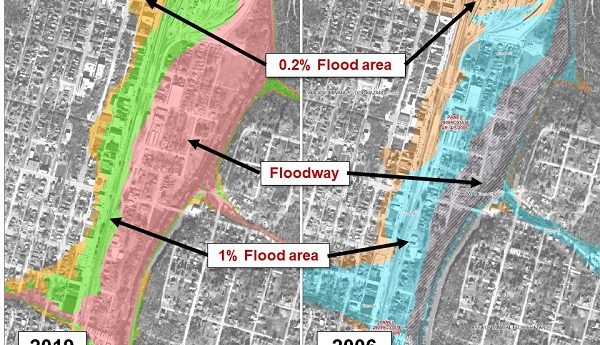Image caption: Updated flood maps for De Soto, MO. Courtesy USACE St. Louis District. (Click here for full-size image)
By Paula Arbuthnot
Paula Arbuthnot is co-founder of Citizens’ Committee for Flood Relief and serves as a community lead for a Thriving Earth project in De Soto, Missouri. On June 6, 2019, The Army Corps of Engineers St. Louis District released a preliminary draft of a Floodplain Management Plan for Upper Joachim Creek.
Yes, this article is meant to be a ‘social impact statement’.
Susan Liley and I have been working this Joachim Creek flash flood issue since December of 2015. Here it is June, 2019, and we are just now – finally! – getting the preliminary results of the Army Corps of Engineers Floodplain Management Plan. And civilian involvement – learning to ask to be a ‘major stakeholder’ – was new to the Corps’ experience, since that role is usually limited to the government bodies, not a Citizens’ Committee. Getting the river gauge as an early warning system was a great achievement with the help of the USGS (Paul Rydlund) to implement that program. Whew!
We knew our situation was bad, but the Corps conservatively doubled the afflicted flood area and doubled the number of homes/businesses involved. Our Thriving Earth Exchange hydrologists (Robb Jacobson, Dan Hanes, and Amanda Cox) rendered their opinions that the Corps numbers didn’t go far enough – and I believe they are right. As an engineer, I have helped my own clients with one dimensional HEC-RAS (Hydrologic Engineering Center – River Analysis System) model studies, assisted in filling out flood elevation certificates, and attended Certified Flood Plain Managers’ school. I know enough that a 1-dimensional flood model is only an educated guess (in my humble opinion), so we are already campaigning for a second phase involving a two-dimensional model flood study.
The Army Corps of Engineers is not really accustomed to being second-guessed on their results and it was sorely needed. I don’t blame them, really, since their regulations limit the methodology they are allowed to use. But technical expertise and third-party verification of the results is paramount to the success of your own studies for planning purposes. DeSoto has made some new civil engineering history, we have created some new science in the process, and our success – if and when that happens – is being watched carefully. Our studies will be used to develop a new modeling technique along with a new way to interact with the civilian communities at large. Already, what we have accomplished in our community will be incorporated and applied to the Meramec River Flood Study, approximately three months behind us.
I am writing this article on the eve of potentially the second highest recorded flood on the Mississippi River with more rain predicted for the next five days. A few levees have already failed. This will be the fourth major flood of the Mighty Miss that I have seen in my lifetime of living in river communities. At times, I feel overwhelmed by it all.
But Susan, as the heart of the Citizens’ Committee, has been rallying the troops, the government leaders, and the residents, grabbing their attention and demanding that we see it through to completion, whatever that may look like. She, more than anyone else I know, has demanded that we can and should do better. This whole experience has been life altering for me in a career that has already been fulfilling. But Susan reminded me about the need for changing our futures – she has taught us all to look for a better day ahead and not be afraid of getting it done.
You see, when you think about it, the scientists have been warning us for years about climate change. The human population has gone through stages of denial and ignoring the issue, especially when we believe that that one individual can’t accomplish much on a larger scale. The politicians have been slow to embrace the needed changes, scared of what that would do their sphere of influence or local economies. We older people even tried throwing up our hands, worried about the mess we have left for our kids to clean up. To me, this sounds like the five stages of grief until finally reaching acceptance. But, this time, acceptance is not enough and the engineer in me says it is now time to get up and “Fix it.”
Thank you, Susan, we needed to hear that.
We have a big, big job ahead of us – don’t be afraid of the odds. Now, it is time to have faith, hopefully work for a brighter future, and be joyful in our efforts. Do it in the name of love, if you have to, but keep telling yourself and the folks around you, that we can ‘turn this around.’

